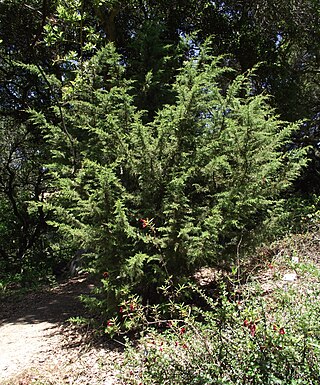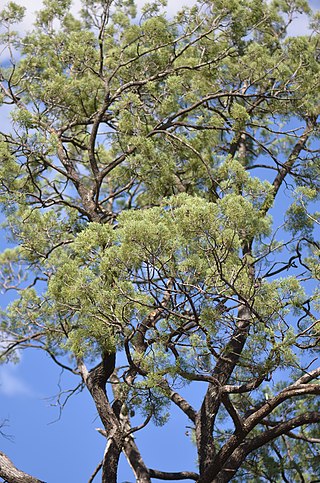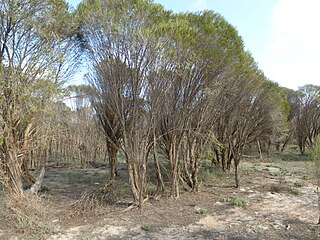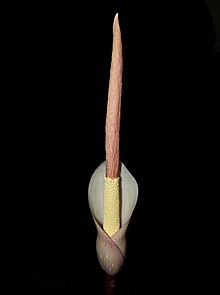
The Araceae are a family of monocotyledonous flowering plants in which flowers are borne on a type of inflorescence called a spadix. The spadix is usually accompanied by, and sometimes partially enclosed in, a spathe. Also known as the arum family, members are often colloquially known as aroids. This family of 140 genera and about 4,075 known species is most diverse in the New World tropics, although also distributed in the Old World tropics and northern temperate regions.

Amorphophallus is a large genus of some 200 tropical and subtropical tuberous herbaceous plants from the Arum family (Araceae), native to Asia, Africa, Australia and various oceanic islands. A few species are edible as "famine foods" after careful preparation to remove irritating chemicals. The genus includes the Titan arum of Indonesia, which has the largest inflorescence of any plant in the genus, and is also known as the 'corpse flower' for the pungent odour it produces during its flowering period, which can take up through seven years of growth before it occurs.

Ficaria verna, commonly known as lesser celandine or pilewort, is a low-growing, hairless perennial flowering plant in the buttercup family Ranunculaceae native to Europe and Western Asia. It has fleshy dark green, heart-shaped leaves and distinctive flowers with bright yellow, glossy petals. It is now introduced in North America, where it is known by the common name fig buttercup and considered an invasive species. The plant is poisonous if ingested raw and potentially fatal to grazing animals and livestock such as horses, cattle, and sheep. For these reasons, several US states have banned the plant or listed it as a noxious weed. It prefers bare, damp ground and is considered by horticulturalists in the United Kingdom as a persistent garden weed; nevertheless, many specialist plantsmen, nursery owners and discerning gardeners in the UK and Europe collect selected cultivars of the plant, including bronze-leaved and double-flowered ones. Emerging in late winter with flowers appearing late February through May in the UK, its appearance across the landscape is regarded by many as a harbinger of spring.

Curtisia dentata is a flowering tree from Southern Africa. It is the sole species in genus Curtisia, which was originally classed as a type of "dogwood" (Cornaceae), but is now placed in its own unique family Curtisiaceae.

Dasiphora fruticosa is a species of hardy deciduous flowering shrub in the family Rosaceae, native to the cool temperate and subarctic regions of the northern hemisphere, often growing at high altitudes in mountains. Dasiphora fruticosa is still widely referenced in the horticultural literature under its synonym Potentilla fruticosa. Common names include shrubby cinquefoil, golden hardhack, bush cinquefoil, shrubby five-finger, widdy, kuril tea and tundra rose.

Spathiphyllum is a genus of about 47 species of monocotyledonous flowering plants in the family Araceae, native to tropical regions of the Americas and southeastern Asia. Certain species of Spathiphyllum are commonly known as spath or peace lilies.

Hesperocyparis goveniana commonly known as Californian cypress and Gowen cypress, is a species of western cypress that is endemic to a small area of coastal California near Monterey. It was formerly classified as Cupressus goveniana.

Diospyros mespiliformis, the jackalberry, is a large dioecious evergreen tree found mostly in the savannas of Africa. Jackals are fond of the fruit, hence the common names. It is a member of the family Ebenaceae, and is related to the true ebony and edible persimmon.

Hesperocyparis lusitanica, the Mexican cypress, cedar-of-Goa or Goa cedar, is a species of cypress native to Mexico and Central America. It has also been introduced to Belize, Costa Rica and Nicaragua, growing at 1,200–3,000 metres (3,900–9,800 ft) altitude.

Corypha umbraculifera, the talipot palm, is a species of palm native to eastern and southern India and Sri Lanka. It is also grown in Cambodia, Myanmar, Thailand and the Andaman Islands. It is one of the five accepted species in the genus Corypha. It is a flowering plant with the largest inflorescence in the world. It lives up to 60 years before bearing flowers and fruits. It dies shortly after.

Callitris columellaris is a species of coniferous tree in the family Cupressaceae, native to most of Australia. Common names include white cypress, white cypress-pine, Murray River cypress-pine, and northern cypress-pine. Callitris columellaris has become naturalised in Hawaii and in southern Florida.

Amorphophallus paeoniifolius, the elephant foot yam or whitespot giant arum, is a tropical plant native to Island Southeast Asia. It is cultivated for its edible tubers in Southeast Asia, South Asia, Madagascar, New Guinea, and the Pacific islands. Because of its production potential and popularity as a vegetable in various cuisines, it can be raised as a cash crop.
Amorphophallus preussii is a species of plant in the family Araceae. It is endemic to Cameroon. Its natural habitats are lowland tropical and subtropical moist broadleaf forests and subtropical and montane tropical and subtropical coniferous forests. It is a Vulnerable species threatened by habitat loss.

Hesperocyparis forbesii, with the common names Tecate cypress or Forbes' cypress, is a nonflowering, seed bearing tree species of western cypress native to southwestern North America in California and Baja California. It was formerly known as Cupressus forbesii.

Tradescantia spathacea, also called the oyster plant, boatlily or 'Moses-in-the-cradle', is an herb in the Commelinaceae family which was first described in 1788. It is native to Belize, Guatemala, and southern México and is widely cultivated as an ornamental houseplant; it has become naturalized in parts of coastal Southern California, Florida, Hawaii, Louisiana, Texas, and various Pacific and Indian Ocean islands.

Amorphophallus titanum, the titan arum, is a flowering plant in the family Araceae. It has the largest unbranched inflorescence in the world. The inflorescence of the talipot palm, Corypha umbraculifera, is larger, but it is branched rather than unbranched. A. titanum is endemic to rainforests on the Indonesian island of Sumatra.

Melaleuca atroviridis is a plant in the myrtle family, Myrtaceae and is endemic to the south-west of Western Australia. It was formerly included in the species Melaleuca uncinata but a review of that species lead to the identification of a number of new species. Like M. uncinata, this species is used for the production of brushwood fencing. It has fewer stamens in the flowers and somewhat smaller clusters of fruit but has the same needle-like leaves with a hooked end and spikes of creamy yellow flowers in early summer.

Allium siculum, known as honey garlic, Sicilian honey lily, Sicilian honey garlic, or Mediterranean bells, is a European and Turkish species of plant in the genus Allium. It is native to the regions around the Mediterranean and Black Seas, and grown in other regions as an ornamental and as a culinary herb.

Linnaea chinensis, commonly known as Chinese abelia, is a species of flowering plant in the honeysuckle family Caprifoliaceae. It is a semi-evergreen, densely branched shrub with dark green foliage.
Garcinia binucao is a species of flowering plant in the Clusiaceae family. It is commonly known as binukaw or batuan, is a species of Garcinia endemic to the Philippines. It is not cultivated, though its edible fruits are harvested from the wild for use as a souring agent in some Filipino dishes.

















